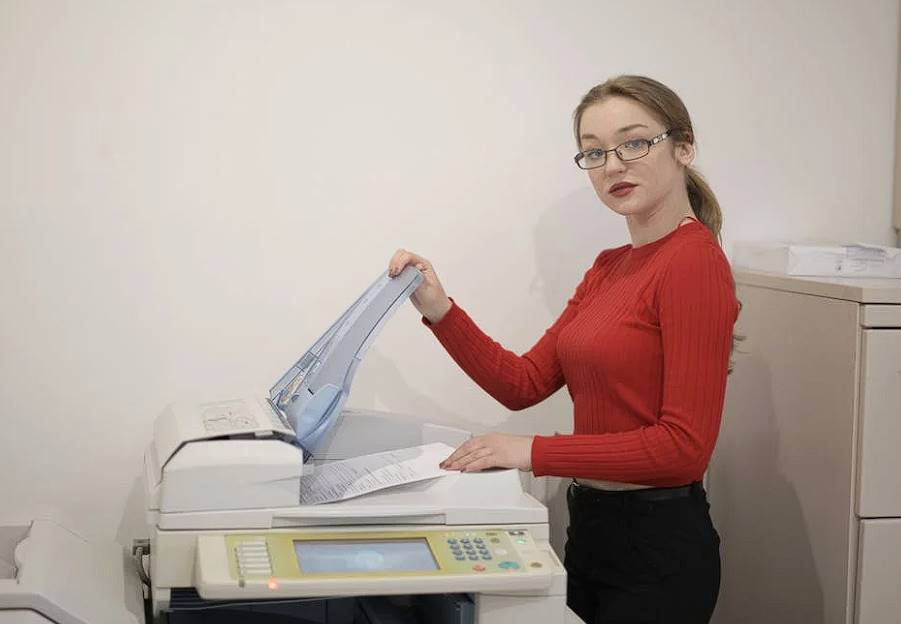Time is money in today’s corporate world, thus efficiency is essential. The capacity to rapidly and efficiently reproduce papers and paperwork is essential for the everyday operations of any organisation, no matter how big or small. A photocopier would be useful at this point.
No company, no matter how large or little, can function without a photocopier. Making several copies of a document in a short amount of time is possible with this method, saving you time and energy. A photocopier may streamline your office’s workflow by making it easy to reproduce everything from reports and contracts to flyers and marketing materials.
Choosing the best office photocopier for your company’s needs can be challenging, though, due to the wide variety of models now on the market. Copying volume, document types, paper size, copying speed, number of available features, ease of upkeep, and other considerations should all be taken into account. An accurate evaluation of your needs and familiarity with the possibilities can help you make a wise choice.
This article will help you choose the best office photocopier for your company’s requirements. We’ll help you through the entire process, from figuring out what you need to how to keep it running well. To ensure that you get the most out of your photocopier, we’ll also provide you some pointers on how to do so.

Do you want to learn more about the type of copier your business actually requires?
These days, consumers may choose from a dizzying array of copy machines, each of which boasts its own unique set of capabilities. Understanding the many machine categories and the many available options will allow you to pick the right one for your specific tasks. Find out what each variety of copier is good for below.
Monochrome Photocopiers
Copier machines that only print in black and white use a single colour of toner, therefore they are referred to as monochrome copiers. Low-end, low-volume machines sit besides high-speed, high-volume counterparts in the marketplace. These photocopiers are designed for use in the office, where aesthetics are less of a priority.
Colour photocopiers
Copies can be made in either colour or black & white with a colour photocopier. All other colours can be made by combining the toners from the four fundamental colours found in a typical printer’s four toner cartridges and four drums: cyan, yellow, magenta, and black. The majority of businesses rely on multifunction devices like colour photocopiers.
Copycats in the Network
With a network connection, network copiers can be used to print from a distance, fax from a personal computer, and scan documents. Digital photo copiers and MFDs typically have a network card, or you can purchase one as an add-on. Everyone in the office may take advantage of wireless printing and scanning by hooking up the copier to the network.
Multipurpose photocopiers
These multifunctional devices can print, copy, scan, and even send and receive faxes, hence the alternative name “all-in-one copier.” The newest models can transport files to other destinations and execute different commands because they can connect to the internet and the office network.
The copier has a USB or wireless connection for printing from mobile devices like laptops, as well as a document finishing function that allows for booklet folding. This type of copier is ideal for organisations that offer additional services, such as the printing of brochures, manuals, and guides for customers.
Workstation photocopiers
Paper sizes less than A4 are not supported by desktop copiers. Desk copiers are either compact models that take up very little room, or multifunction devices that can print, scan, and copy. They function similarly to a multifunction copier, but they are too bulky and heavy to be used on a desk, hence they are limited to sizes up to A2.
Large-format photocopiers
In just a few short minutes, a wide-format copier can produce flawless carbon copies. Tiny ink droplets are ejected from the copiers, allowing them to produce high-quality copies. Graphic designers use them for marketing materials, architects use them for blueprints, and teachers use them for lesson plans.
What Should You Look For When Purchasing a Copier?
Most enterprises would struggle to function without a copier. Large-scale production of marketing materials and personnel paperwork are now possible thanks to the machine. To get the most value out of your money and the capabilities of your copier, you should base your purchase decision on your unique copying requirements.
To ensure a smooth workflow in your office, a business copier will likely be one of your largest purchases. Whether you’re looking to purchase a single copier for a home office or a fleet of copiers for a large corporation, it’s important to do your research to ensure that the equipment meets your needs without breaking the bank. Some machines require frequent maintenance, so it’s important to research and evaluate different models, service plans, and warranty terms before making a final decision.
Purchasing a new commercial copier is a huge deal whether you run a small company or a large, high-volume operation. It’s not as easy as looking at the price tag when shopping for a new copier to locate one that fits your budget. Although price will likely play a role in your final decision, it is not the only element to think about. The following list of considerations will aid you in finding the print device that is best suited to the needs of your organisation.
Tips for Choosing the Right Office Printers
Is a new printer for your company something you need? It can be challenging to choose the right product for your company’s needs from the many accessible brands, models, and varieties. In this article, we will go through the top 10 things you should think about before buying a printer for your business.
Imitation Speed
This crucial figure reveals the rate of the office printer’s copying and printing capabilities. This metric, expressed as a number of pages per minute, is often brought up first when shopping for a new piece of office automation equipment. Faster business printers also tend to produce more copies per copy, and vice versa. Typically, the print/copy speed of a commercial printer meant to be shared by 3–10 users falls somewhere in the middle volume range, between 25 and 45 pages per minute (ppm).
Copy Volume
This is the maximum monthly page volume for which the office printer was intended to be used. As the volume of copies made on an office automation device increases in direct proportion to its copy speed, business printers with slower copy speeds are optimised for handling fewer copies and prints per month. Business printers are typically categorised by volume rather than by actual numbers for the sake of clarity. Small office/home office (SOHO) equipment is designed for seldom use and can be classified as light, medium, heavy, or commercial. If you’re looking to buy a printer for your company, it’s important to take into account how often you anticipate using it.
Capacity of the Network
When investing what may be a sizable sum in office automation, firms naturally want to maximise the returns on that investment. Connectivity to a customer’s local area network (LAN) is a crucial component of multifunction commercial printers. When linked to a network, even a simple office printer can perform the duties of a high-powered network printer, scanner, fax server, and more. Think about the OSes you use and where you want the device to sit in the network when evaluating its network capabilities. Today, network capabilities are built into the design of the vast majority of office printers.
Scanning Functionality
If you need a powerful network scanner, a network-connected commercial printer is your best bet. Many modern photocopiers feature colour touchscreen interfaces and internal processing hardware that can keep up with that of most desktop computers, allowing you to scan directly to your computer, an email address, or even into your key business applications like Sage, Goldmine, and many more. The scanning capabilities of prospective office printers should be evaluated for their potential to improve workflow and cut costs.
Extra Functions and Advantages
The usual feature set of today’s office automation devices is vastly expanded upon. The touchscreens on today’s modern office printers are typically built on an open source programming framework. Many “bolt on” programmes have been developed by programmers to improve your printing, copying, and scanning.
Manufacturer
After you have an understanding of the office automation device’s capabilities, speed, and benefits, you may want to investigate the company behind it and its track record with similar products. Sharp, Canon, Toshiba, Samsung, and Konica Minolta are just a few of the well-known brands that compete in the office automation industry. Depending on personal preference, many office automation resellers will only carry products from one or two manufacturers. In most cases, it’s best to buy hardware from a well-known company that has a sizable part of the market and can therefore sustain its relationship with both you and your selected reseller. The Environmental Policies and perspectives on Corporate Social Responsibility of the manufacturer are another factor to think about; this information is typically available on the manufacturer’s website.

Obtainable Arrangements
The contemporary buyer is on the lookout for more adaptable ways to obtain the money for office automation devices in an era where capital expenditures are tightly limited and monitored. It’s important to find a supplier who offers flexible payment terms, not just outright purchase, when making your selection. Now more than ever, companies are turning to printer leasing as a tax-wise option for acquiring workplace printers and other office equipment. Leasing also provides a great option for upgrading to newer models of the same equipment, so you can rest assured that your investment will always be cutting edge.
After-Sale Service
You should think about backup plans when buying a commercial printer that will be used in a digital document workflow in case the machine breaks down. Due to the high number of moving parts inside, it’s nearly certain that a modern office printer will experience some sort of mechanical breakdown at some point. An after-sale support infrastructure, typically in the form of a full service agreement, will be in place at the major office automation resellers. Standard service contracts price a per-print or per-development fee and include all labour and components needed to repair the machine. Consider the supplier’s after-sale service options, including pricing and whether or whether the company employs its own technicians or contracts with an outside service provider, before making a final decision.
Compatibility
Because business networks are complex systems made up of a wide variety of technologies, it is crucial to check compatibility before deciding to add a network-capable office automation equipment. To make sure your multifunction business printer is compatible with your network and the software programmes you use, reputable providers of office automation should do surveys before installing the device. However, most state-of-the-art office printers are compatible with industry standard programmes and network gear. The product brochure typically contains further details about the device’s compatibility.
Price
Price is always an important consideration when making a purchase, but research shows that many consumers do not place a premium on lowest price when shopping for office automation. You can easily compare prices for the business printer you’re considering by visiting one of the many dedicated websites to the industry. The cost of a system should take into account not just the cost of the hardware itself, but also the cost of the additional features and workflow capabilities that come standard on modern office automation devices.
Conclusion
Efficiency is essential in today’s corporate world, where time is money. A photocopier is crucial for any organisation, big or small, to reproduce papers and paperwork quickly and efficiently. However, choosing the best photocopier can be challenging due to the wide variety of models available, and several factors must be taken into account, such as copying volume, document types, paper size, copying speed, available features, and ease of upkeep. This article provides an overview of various types of photocopiers and what each type is suitable for. To ensure that you get the most out of your photocopier, the article also provides pointers on how to do so. To select the right copier for your needs, it is crucial to assess your requirements and consider factors such as maintenance, service plans, and warranty terms.
Content Summary:
- Time is money in today’s corporate world, thus efficiency is essential.
- A photocopier is essential for the everyday operations of any organization, no matter how big or small.
- No company can function without a photocopier.
- A photocopier can rapidly and efficiently reproduce papers and paperwork.
- A photocopier can streamline your office’s workflow by making it easy to reproduce everything from reports and contracts to flyers and marketing materials.
- Choosing the best office photocopier for your company’s needs can be challenging due to the wide variety of models now on the market.
- Copying volume, document types, paper size, copying speed, number of available features, ease of upkeep, and other considerations should all be taken into account when choosing an office photocopier.
- An accurate evaluation of your needs and familiarity with the possibilities can help you make a wise choice when selecting an office photocopier.
- Monochrome photocopiers only print in black and white and are designed for use in the office where aesthetics are less of a priority.
- Colour photocopiers can make copies in either colour or black & white and rely on multifunction devices.
- Network copiers can be used to print from a distance, fax from a personal computer, and scan documents.
- Multipurpose photocopiers can print, copy, scan, and even send and receive faxes, and can connect to the internet and the office network.
- Workstation photocopiers are limited to sizes up to A2 and are either compact models that take up very little room or multifunction devices that can print, scan, and copy.
- Large-format photocopiers can produce flawless carbon copies in just a few short minutes.
- Tiny ink droplets are ejected from large-format photocopiers, allowing them to produce high-quality copies.
- Graphic designers use large-format photocopiers for marketing materials, architects use them for blueprints, and teachers use them for lesson plans.
- To ensure a smooth workflow in your office, a business copier will likely be one of your largest purchases.
- Researching and evaluating different models, service plans, and warranty terms is important before making a final decision on purchasing a copier.
- Price is not the only element to think about when purchasing a copier.
- Different models of copiers require different levels of maintenance.
- Large-scale production of marketing materials and personnel paperwork are now possible thanks to the machine.
- Purchasing a new commercial copier is a huge deal whether you run a small company or a large, high-volume operation.
- The following list of considerations will aid you in finding the print device that is best suited to the needs of your organization.
- When purchasing a copier, it is important to base your decision on your unique copying requirements.
- The capacity to rapidly and efficiently reproduce papers and paperwork is essential for the everyday operations of any organization, no matter how big or small.
- A photocopier can help streamline your office’s workflow and save time and energy.
- A photocopier can make it easy to reproduce everything from reports and contracts to flyers and marketing materials.
- Understanding the many machine categories and the many available options will allow you to pick the right copier for your specific tasks.
- Some copiers have a USB or wireless connection for printing from mobile devices like laptops.
- The newest models of copiers can transport files to other destinations and execute different commands because they can connect to the internet and the office network.
Frequently Asked Questions
What is an office photocopier?
Office photocopiers are larger devices than a desktop photocopier and tend to be floor standing. These devices are able to deal with larger volumes than desktop photocopiers and can often print at higher speeds, whilst offering a range of different functions including: scanning, copying and faxing.
How does a photocopier contribute to office efficiency?
Copiers can convert scanned documents, PDF files, and other images into editable and searchable files. This helps organizations prevent loss of data and manage their files more efficiently. The ability to preview documents before printing is another feature that makes copiers more efficient.
What are the advantages of using a photocopier?
One of the strongest advantages of a photocopier is its ability to enable an individual to seamlessly copy both sides of a document. If a document has input on both sides, then the photocopier can be easily configured to print a two-sided copy.
What are the benefits of machine in business?
Machines generate more production with minor energy and within a limited time. Worker might be more dedicated to their work when they make use of machines. Improvement in the quality and quantity of products, as a machine, ensure high and large production rate.
What are the benefits of machine working?
Simple machine reduces human effort. Simple machine increases the speed of work. Force can be increased. Simple machine reduces time consumption.

